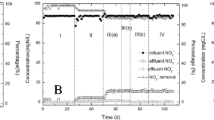Abstract
The ability of a sulfide- and glutaraldehyde-tolerant strain ofThiobacillus denitrificans (strain F) to control sulfide production in an experimental system of cores and formation water from the Redfield, Iowa natural gas storage facility was investigated. A stable, sulfide-producing biofilm was established in two separate core systems, one of which was inoculated with strain F, and the other core system (control) was treated in an identical manner, but was not inoculated with strain F. When formation water with 10 mM acetate and 5 mM nitrate was injected into both core systems, the effluent sulfide concentrations in the control core system ranged from 200–460 μM. In the test core system inoculated with strain F, the effluent sulfide concentrations were lower, ranging from 70–110 μM. In order to determine whether strain F could control sulfide production under optimal conditions for sulfate-reducing bacteria, the electron donor was changed to lactate, and inorganic nutrients (nitrogen and phosphate sources) were added to the formation water. When nutrient-supplemented formation water with 3.1 mM lactate and 10 mM nitrate was used, the effluent sulfide concentrations of the control core system initially increased to about 3800 μM, and then decreased to about 1100 μM after 5 wk. However, in the test core system inoculated with strain F, the effluent sulfide concentrations were much lower, 160–330 μM. Nitrate consumption (5 mM) and high concentrations (107–108 cells/mL) of strain F were detected in the test core system. An accumulation of biomass occurred in the influent lines during 2 mo of continuous operation, but only a small increase in injection pressure was observed. These studies showed that inoculation with strain F was needed for effective control of sulfide production, and that significant plugging or loss of injectivity owing to microbial inoculation did not occur.
Similar content being viewed by others
References
Orr, W. L. (1977),Advances in Organic Geochemistry, Campos, R. and Goni, J., eds., Enadimsa, Madrid, pp. 571–597.
Montgomery, A. D., McInerney, M. J., and Sublette, K. L. (1989),Biotech. Bioeng. 35, 533–539.
McInerney, M. J., Bhupathiraju, V. K., and Sublette, K. L. (1992),J. Indust. Microbiol. 11, 53–58.
Tanner, R. S. (1989),J. Microbiol. Methods 10, 83–90.
Sublette, K. L. and Sylvester, N. D. (1987),Biotech. Bioeng. 29, 245–257.
Lee, C. M. and Sublette, K. L. (1993),Water Res. 27, 839–846.
Widdel, F. (1988),Biology of Anaerobic Microorganisms, Zehnder, A. J. B., ed., Wiley-Liss, New York, pp. 469–585.
Author information
Authors and Affiliations
Rights and permissions
About this article
Cite this article
McInerney, M.J., Wofford, N.Q. & Sublette, K.L. Microbial control of hydrogen sulfide production in a porous medium. Appl Biochem Biotechnol 57, 933–944 (1996). https://doi.org/10.1007/BF02941774
Issue Date:
DOI: https://doi.org/10.1007/BF02941774




